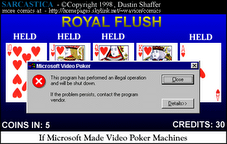Patents license already becomes a franchising facility except our granular treatment of such a history and metacloud boggles the mind. With the VCSY patents and an evolving workflow toward the SOA/SaaS mean.
Patents then become description packets to allow the construction of a system that may also integrate and flwo into another such patent or many different copyrighted versions of such patents all for the purpose of analyzing the business and assessing value and payment.
It's really not all that difficult to draw up when everything is virtualized and arbitrated. Otherwise, it's just so much hard code and meatballs.
Why can't software be done that way including elemental pricing and commoditization of components as they begin life until they end life? Why not indeed. Arbitrary information theory allows for ANYthing of ANY nature especially when the facility is provided to interface the processing stream with a physical sense and actuation system aka "hardware".
What we are seeing portends a gigantic series of industries with VCSY material interwoven throughout the information and production and controls systems of industry. As it stands, Microsoft is a general purpose set of applications to address any job within a human oriented office. "People" ready.
VCSY renders all of that "Machine" ready.
This offers to evolve into something easily dwarfing what Microsoft is trying to do by becoming a family server in a closet. The sheer paucity of their vision starkly betrays the efficacy of billions spent to chase specters and haints. Billions to chase what was always there all the time.
May 14th, 2007
Software is hand made
Posted by Dana Blankenhorn @ 7:49 am Categories: General, Development, Legal, Strategy, business models
Recent comments here by Anton Philodor made me realize something important about software, that it's hand made.
Despite the rise of new languages, new tools, and new ways to find bugs, all aimed at increasing productivity, the fact remains that software writing today is still a craft.
Creating good software is a group effort, but it's done by trained craftsmen. It's not a painting, but neither is it a car. It's more like a piece of Wedgwood.
I recently finished The First Tycoon, a fine biography of Josiah Wedgwood, who was a contemporary of Adam Smith and (although he never knew it) one of Charles Darwin's grandfathers. While his name is now a byword for luxury he was, in fact, a potter. His Etruria Works was in fact a crafts shop, and might be considered the Redmond of its day.
While it took management and direction to make a fine pot, it also took skilled craftsmen. In his book Brian Dolan describes how Wedgwood's main business rival, Matthew Boulton, tried to get into the pots business against Wedgwood and failed. His quality wasn't as good and he had too many rejects.
Boulton later backed Watt's steam engine, which transformed the world far more than Wedgwood did, but such a device does not yet exist for creating software. When we talk of competing with China and India, we're talking about competing against trained minds, not machines.
If we could fully automate software production, as the steam engine automated manufacturing, it's possible the open source movement would cease to exist. But so long as PCs remain essentially looms in software production, or kilns to continue the Wedgwood analogy, capitalists won't hold all the power.
----
The elemental capabilities within the SiteFlash/MLE/Emily architectural principles provide for a base of automation of the software construction capabilities arbitrating virtualized components offers. I would think this is an ultimate goal of the team as evidence by their holding of the Cruz fiber optic patent ( I would say some have been digging: http://www.google.com/search?hl=en&q=cruz+fiber+optic&btnG=Google+Search how can we tell? The earthworms have stratified the layers in the google mush. )






1 comment:
timing
http://news.com.com/Microsoft+agitates+for+open-source+patent+pacts/2100-7344_3-6183662.html?tag=nefd.lede
"...adding that the company released the tally of potentially infringing patents now only after three years of effort to come up with a "constructive" way of dealing with the situation..."
Post a Comment